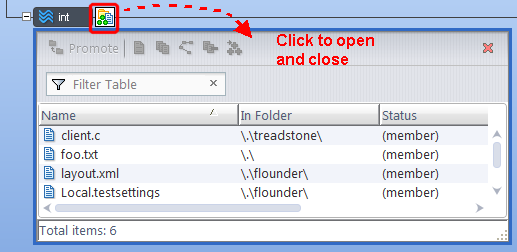The Default Group of a Workspace or Stream
For each dynamic stream and workspace (but not for pass-through streams, snapshots, or reference trees), AccuRev keeps track of the elements that are currently under active development in that context. This set of elements is called the default group of the stream or workspace.
How Elements Become Members of the Default Group
|
Workspace |
The default group is a property of the workspace stream, maintained in the AccuRev repository. There are no "hidden files" or other administrative structures in the workspace tree to keep track of which elements are active. The following commands cause an element to become a member of the workspace's default group. Note that these commands can be executed only in a workspace, not in a stream.
|
|
Dynamic Stream |
When a version is promoted to a dynamic stream, the element becomes a member of the stream's default group. |
If an element is already in the default group of a workspace or stream when one of the commands listed above is executed, the element simply remains a member. In other words, the default group's membership doesn't change when it's viewed as a set of elements. But it does change if you view the default group as a set of particular versions of those elements.
How Elements are Removed from the Default Group
For both a workspace and a dynamic stream, the following commands remove an element from the default group:
- Promote (to the immediate parent stream)
- Revert to Basis
The element returns to a passive state in the workspace or stream. A stream returns to inheriting a version of the element from its parent stream; a workspace returns to acquiring versions of the element from the backing stream through the Update command.
Cross-promoting an element to a stream that is not the immediate parent stream does not remove the element from the default group of the "from" stream.
Viewing the Contents of the Default Group
The StreamBrowser can show the development activity currently taking place in each stream or workspace.

A control below the stream or workspace opens or closes a subwindow that displays the details of the development activity. The activity details can appear in several ways — by element, by transaction, or by issue record.
For a dynamic stream, the by-element display is a listing of the stream's default group. For a workspace, this subwindow displays those members of the default group that are displayed in the File Browser’s Outgoing Changes mode (see discussion below).
Default Group vs. Outgoing Changes in a Workspace
A workspace's set of active elements (that is, its default group) is not necessarily the same as the set of elements that have changed in the workspace. In practice, the sets will often be the same. But in theory, the sets are overlapping, but not identical:
- The Default Group shows only those elements with a status of (member). This status can be the result of "checking out" elements using Send to Workspace or Anchor commands, or simply the result of adding a new file to the workspace.
- The Outgoing Changes mode includes elements in the Default Group, but it can also show external objects and missing elements.










